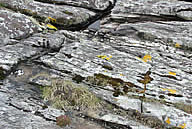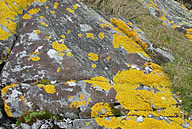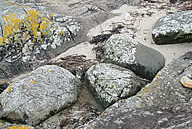
Tarbert Geology
The geological history of Kintyre can be investigated by the huge amount of evidence of rock that is displayed all across the hills and coastline. It would appear that most of the rock types are sedimentary in structure, layered similar to slate, however it is clear at some point that there has been a lot of volcanic activity which has turned these sedimentary rocks to metamorphic.
Metamorphic rocks are sedimentary (layered rocks built up and compressed over time) or igneous (crystalline structured rocks formed below the surface of the earth, such as granite, or lava cooled on the earths surface after being expelled by volcanic activity) that have been altered by pressure or coming into contact with molten material.
Shale, may be altered into slate and sandstone into quartzite (of which is in abundance in all across Kintyre, from the hills all the way to the shores). When these alterations occur the rocks are then known as metamorphic instead of their original type.
Argyll itself consists mostly of metamorphic rock.
It is also interesting to note that all across Kintyre there are masses of large loose rocks, found a huge distance away from similar rocks of the same type. This would have occurred through glaciers carrying or dragging rocks across the land and valleys and then at the end of the ice age, when the ice melted forming fresh water lochs, tributaries and rivers the rocks simply settled where the ice left them. It is thought that there would have been huge glacial activity here during the ice age, which formed the hills and valleys we know today. Loch Fyne is thought to have been carved by huge glacial activity, similarly Loch Awe and many other fresh water lochs share the same geological history.
The soils in Kintyre and Argyll range from sandy, peaty and gravelly with a high content of mosses across the length and breadth of the county resulting in excellent drainage in some areas and high water retention in others. There is a high quantity of limestone across Argyll, with more in mid Argyll than anywhere else in Argyll, this is synonimous with rich and productive soils.
Most of the land that surrounds Tarbert is peaty and mossy, perfect for forestry which is why there is a huge amount of forestry and woodland across the north of Kintyre.
I hope that information is both accurate and interesting. There are many books available in Tarbert Library, not only about geology, but also about fishing, history and much much more. Interested in finding out more, then why not go in and read more about Tarbert and Kintyre.


